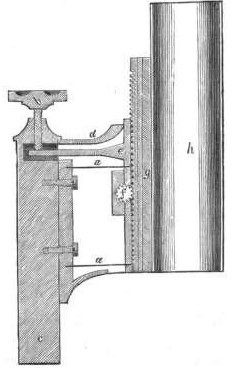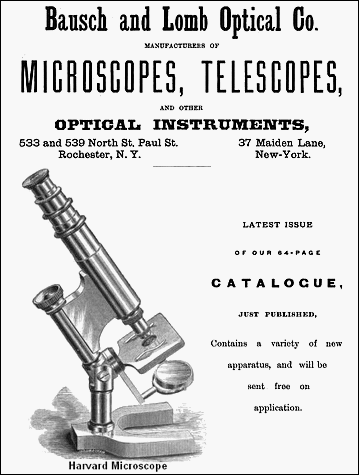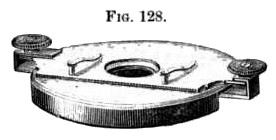
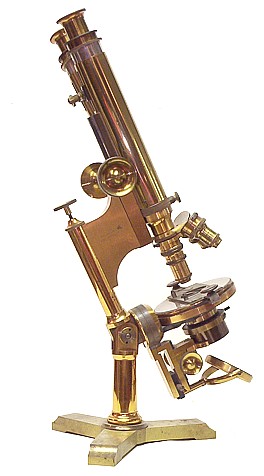
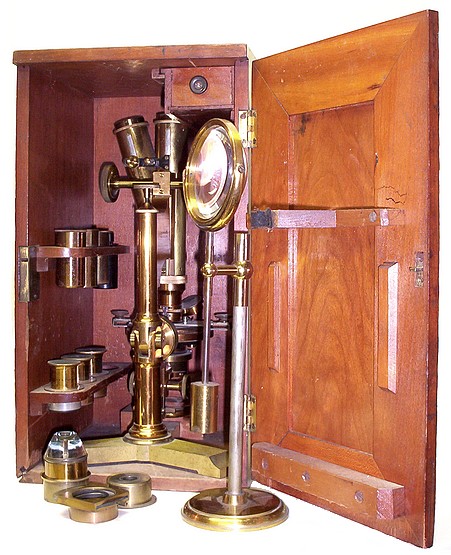
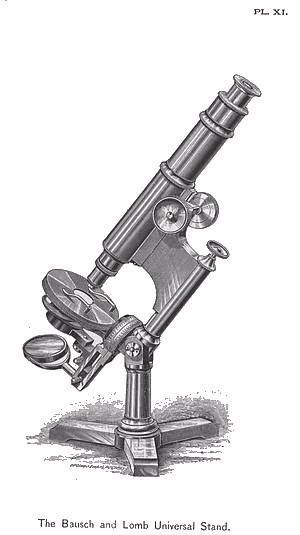
From: Behrens Guide to the Microscope in Botany, 1885
This stand, made by the Bausch and Lomb Co., is represented 1/2 natural size in Plate XI. It comprises the same general features as the one last named, but by a slight increase of distance between the stage and the table sufficient space is secured to admit the use of the largest illuminating or polarizing apparatus, etc., that is usually employed on the largest stands. In fact there is scarcely any of the accessory apparatus of the highest-priced microscopes that cannot, with a few slight modifications in non-essential particulars, be easily and efficiently combined with this. This stand can be obtained as shown in the cut, in a very simple and inexpensive style; but it is capable of a much higher development. It has been constructed, for the use of the writer, with the addition of lengthening mirror bar, graduated draw-tube for use in micrometry and in drawing to scale at any desired amplification, centering adjustment to stage, and graduated rotation of the same, centering substage moved vertically with rack and pinion, and graduated fine adjustment screw with index point, for use in measuring approximately the thickness of objects or cover-glasses. It is named by the makers the "Universal," from the belief that it is possessed of the working capacity of the most elaborate stands. The stage is well adapted to the use of a glass sliding stage; and a mechanical stage moved in all directions by special mechanism can be added if desired.
The binocular arrangement of the Wenham tube used with the Bausch & Lomb microscopes is described in the Sharp & Smith Catalog of Surgical Instruments, 1889 as follows:
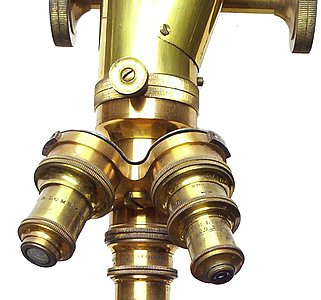
The Wenham prism on this microscope utilizes a patented mechanism for its mounting as described in the 1884 US patent 293,217.
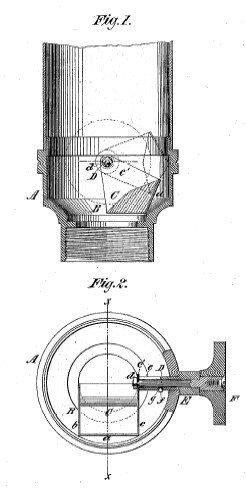
BINOCULAR MICROSCOPES.
(PATENTED Feb. 12. 1884)
The purpose of the binocular microscope is to give a stereoscopic vision of objects whereby their form, relative distance and position of the various parts are most plainly seen. The effect is striking and is so totally different from the image in the monocular, that it can only be fully appreciated after it has been observed. Different methods for accomplishing the same purpose have been used, but the one in most general use is that devised by Mr. Wenham;by this plan the rays coming from the objective are equally divided, one-half of them passing through the vertical tube without alteration, while the other half is reflected by the interposing prism, thus giving almost equally illuminated field in both eye-pieces. The prism is mounted in a sliding box which is fitted to the nose-piece, and by which it may be put in its proper position or partially withdrawn. The great advantage of this system is that the instrument may be used as a monocular by withdrawing the prism; but in this respect it is open to serious criticism, especially of late years, in that the size of the prism and its mountings are limited by the internal diameter of the nose piece and so decreases the opening for the passage of rays, that many of the advantages of good objectives have been lost. Provision has lately been made to remove the nose-piece altogether when used as a monocular, and replace it with one which is free from obstruction; this however consumes time, and is not always practical.
For some time it has been our purpose to obviate these difficulties, and we have succeeded in devising a number of improvements of which we have adopted the one described below; it is at once the most simple and effective. It is contained in the nose-piece which is attached to the tube; the prism, instead of being mounted in a sliding box, is fixed in a swing carriage, b which the axis is in c. The carriage b is fixed to the steel spindle r, which in turn passes through a sleeve in the nose-piece, and is provided with a milled head, by which it is turned; the spindle and sleeve are arranged with stop-pin to limit the motion of the prism; e is the vertical, and f the oblique tube. As the posterior system of any objective with society screw does not exceed 15 m. m., we have made the opening d in the nosepiece of this size. When the prism a is in position for binocular vision, as shown in full lines, all the rays coming from the objective will be utilized, whereas when the instrument is used as a monocular and the prism is swung to the side of the tube, as shown in dotted lines, the opening d is left without obstruction. In addition to this advantage, the fittings are all close, so that there is no opportunity for the dust to enter, and being cylindrical, there is practically no wear. The draw-tubes are provided with adjustment which works them simultaneously, and accommodates eyes different distances apart. A tightening screw is also provided, whereby the tubes may be fixed at any point at which they are set.
Beside the above advantages, this form of binocular and the arrangements of the prism permit the use of higher power objectives than is the case in others. Thus a 1/4 inch objective gives an excellent stereoscopic effect, while a £ may be made to do so, with some practice. This is of considerable importance in all cases where the above powers are required.
From the B&L Price list, 7th ed., 1882:
Bausch and Lomb Optical Co.'s Glass Stage and Slide-carrier.This (Fig. 128) is intended as a substitute for the mechanical stage to a certain extent. It consists of a polished plate of glass, incased in a brass ring, which clamps on the circular stage. The slide-carrier, which moves on it, consists of a light metallic plate, and has protruding from its lower surface four small points; at its two ends are prolongations, which are bent downward and inward, and, acting as springs, press against the lower surface of the glass. As the contact between glass stage and slide- carrier is only in these six points, friction is reduced to a minimum, and the action of the latter, although firm, is smooth and steady. It is claimed that it enables work to be done with far more facility than in the ordinary brass stage, where the entire surface of the slide bears on it, and that it is altogether more agreeable. The slide- carrier is provided at each end with small milled heads for manipulation, and has spring clips and a stop for Maltwood finder.
From the Journal of the Royal Microscopical Society:
Bausch and Lomb Optical Co.'s Fine Adjustment. Fig. 126 represents the original of the fine-adjustment referred to at Vol. I. (1881) p. 110. Two strong parallel blades of finely tempered steel, a a, are securely fastened on one end to the back of case Fig. 126. d, on the other to the arm e, which carries the rack and pinion, b shows the micrometer screw, which is fitted to the upper part of the upright arm c, f is the pinion, g the rack and slide, h the tube. Two screws fasten the adjustment case d to the pillar c. An arm projects from the part e and passes into a recess in the pillar c. The springs support the entire body, and as their tension is upward, the projecting arm bears continually against the micrometer screw b, and it is evident that tho distance traversed by tho screw involves the same movement of the arm e, and consequently the body. The only points of contact are at the ends of the springs a, a, where they are fastened respectively at d and e, and on the micrometer screw, and as in the former there is absolutely no friction, there is no wear; while that which may eventually take place in the latter is taken up by the force of the springs.The points of excellence claimed by the makers for this adjustment over all others, are the following: 1. It moves the entire body. 2. It is extremely sensitive and direct. 3. It has no lateral motion or displacement of the image, while adjusting. 4. It has absolutely no lost motion. 5. It can in no manner deteriorate.
